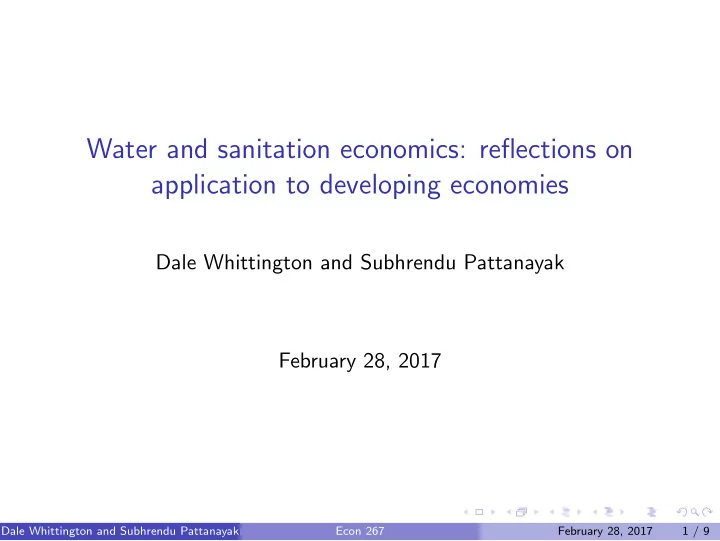

Water and sanitation economics: reflections on application to developing economies Dale Whittington and Subhrendu Pattanayak February 28, 2017 Dale Whittington and Subhrendu Pattanayak Econ 267 February 28, 2017 1 / 9
Background Cost-benefit analysis is uncommon in the WASH (water, sanitation and hygiene) Benefits Commonly used methods Key challenges Dale Whittington and Subhrendu Pattanayak Econ 267 February 28, 2017 2 / 9
Simple analytic model Stylized framework to evaluate water and sanitation technology (Pattanayak et al., 2005) Household maximize utility from leisure ( T 1), health ( S ) and composite consumption good ( Z ) S { water quality Q , the extent of coping activity a } water quality Q : public policy ( G ), e.g. sewage and piped water network and hygiene education, and averting behavior in the community ( A ), e.g. open defecation coping activity a : T 2, M material and K ( r ). Privacy, comfortable L T 1 , T 2 , Z , M , K , a ,λ,µ = MaxU [ T 1 , Z , S ( a , QG , A ) , a ; θ ] − λ [ f ( a , T 2 , M , K )] + µ [ E + w ( T − S − T 1 − T 2 ) − pM − rK − Z ] Dale Whittington and Subhrendu Pattanayak Econ 267 February 28, 2017 3 / 9
Benefits less sick days and save time to engage in the income-generating activities (not always) Aesthetic benefit, high quality life. lower mortality rate positive externality for community cleanliness social norm, social interaction (Brock & Burlauf, 2001), e.g. open defecation-free community Dale Whittington and Subhrendu Pattanayak Econ 267 February 28, 2017 4 / 9
Approaches to benefit estimation Water demand function, derive unity maximization problem cost saving analysis: ignore non-health cost, data collection and identify travel cost model: expensive, all available water sources, Ukunda, Kenya(Whittington et al., 1990) Dale Whittington and Subhrendu Pattanayak Econ 267 February 28, 2017 5 / 9
Approaches to benefit estimation hedonic property value model(revealed preference approach) market premium: connection to the piped water downward biased: subsidy; actual price not sales price; isolate the effect stated preference: contingent value or choice experiment method familiar with improved water, meta-analyses of SP (Abramson et al., 2011; Van et al., 2013), no significant difference across the regions negative signal Dale Whittington and Subhrendu Pattanayak Econ 267 February 28, 2017 6 / 9
Challenges unperceived benefits, ex ante < ex post Monetizaition of benefits: Death = CFR ∗ Pop ∗ Eff ∗ Inc Mortalitybenefits = VSL ∗ Death , moral issue, multiple of annual income valuing nonresidential water use, mobile people, uninitiated business Dale Whittington and Subhrendu Pattanayak Econ 267 February 28, 2017 7 / 9
WTP to water service by firm managers in Uganda Evidence from Uganda that firms’ WTP is relative low (Davis et al., 2001) Dale Whittington and Subhrendu Pattanayak Econ 267 February 28, 2017 8 / 9
Other perspectives of benefits side dynamic model, virtuous cycle by WASH investment Humanitarian aid, lift more people out of poverty Dale Whittington and Subhrendu Pattanayak Econ 267 February 28, 2017 9 / 9
Recommend
More recommend